Celebrating 50 years of the S æí An Exhibition

Sæí's 2024
General Election endorsements
Sec. 2 cover

Queer nightlife goes "boo-jee!"
Sec 2. pg. 9

Seattle Queer Film Festival returns
Sec. 2 pg. 12





Celebrating 50 years of the S æí An Exhibition

Sæí's 2024
General Election endorsements
Sec. 2 cover

Queer nightlife goes "boo-jee!"
Sec 2. pg. 9

Seattle Queer Film Festival returns
Sec. 2 pg. 12




by Kylin b rown

On June 27, dozens of members of the SGN community, including writers from throughout the paper's history, gathered at the opening reception of the exhibit "Seattle Gay News Celebrates 50 Years!" Seattle Mayor Bruce Harrell spoke about the paper's rich and impactful history for the region's LGBTQ+ community over the last five decades, and declared June 27, 2024, "Seattle Gay News Day".
The exhibit, which includes largerthan-life displays of archived SGN pages covering historic and often-overlooked LGBTQ+ news and events, was created by the University of Washington Libraries and originally displayed at Allen Library in March 2024. Highlights include coverage of the AIDS crisis, including memorials and obituaries; the fight for marriage equality and other civil rights; and the digital preservation of SGN archives.
The SGN now stands as one of the longest-running LGBTQ+ newspapers in the world. While ever-evolving, a constant lifeline of care and maintenance has been its beating heart, including long-time reporter and now owner and publisher Renee Raketty.
"Seattle Gay News Celebrates 50 Years!" was a free and open to the public exhibit on display in the eighth floor gallery of the Seattle Central Library from June 24, 2024, through September, 22, 2024.





June 24 through September 22, 2024
"Our history helps us understand our past and brings context to our present….Our history helps shape our identity, both collectively and individually. A lot of us lived through the history printed on these pages of SGN. Our history honors those who are with us and those who came before us. We have a long way to go for equality but even so, we stand on the shoulders of a lot of others who sacrificed for many of the gains and freedoms we have. To me, observing our history honors their journey."
Mike Schultz, SGN Owner through June 2024
King 5 News, November 27, 2023
Exhibit Curators: Alisa MacDonald, Jessica Albano, Norah Murphy, Sam Stringer, & Sydney Nguyen

Special thanks to UW Libraries staff: Benny, Cass, Marc Albert, Theresa, & Sandy
Special thanks to our partners at Seattle Gay News (past and present), Seattle Public Library, Washington State Library, Seattle Municipal Archives, and MOHAI.
For questions about this exhibit, please contact Jessica Albano, jalbano@uw.edu




The first version of Seattle’s Gay Community Center (GCC), conceptualized as a space where local gay people could gather outside of bars or clubs, was established in Pioneer Square in 1971. This location was forced to close due to rising rents in 1972. In 1974, the GCC re emerged on 16th Ave in the Capitol Hill neighborhood, which was (and still is) the center of Seattle’s LGBTQ+ community.

This location burned down in an act of arson in spring 1976; the fire was the second set to the building in two weeks.
The GCC moved to a new Capitol Hill location and remained in this neighborhood until 1980, when the Center moved to the South Lake Union neighborhood before closing in 1981.

The GCC supported many community efforts including publications, one of which became the Seattle Gay News SGN began its life in 1974 under the title News. This was not the Center’s only publication: Out and About, a feminist newsletter published by and for the Seattle lesbian community, was headquartered at the GCC beginning in 1976.
The News was edited by Jim Tully, who remained the editor as the publication developed into a journalistic pamphlet titled Seattle Gay News in 1976, before becoming a tabloid style newspaper in 1977. The paper was published by the Gay Community Center until 1979, at which point tensions between the GCC board and the paper’s editors led to an acrimonious split. A new GCC newsletter emerged in the aftermath, and in a long article early in its run, the publication took SGN to task for claims of misogyny.






Originally part of the Gay Community Center (GCC), SGN has moved to various locations throughout Seattle since it was founded in 1973. Here is a brief history of the many places SGN has been and where it is today.
1977: 110 Boylston Ave E
The Gay Community Center moved here after an arson attack in spring 1976 forced them to relocate.
1979: 107 Eastlake Ave E
SGN departs from the Gay Community Center and move with other LGBTQ+ organizations to a new location.
2020: 509 10th Ave E
SGN currently resides here.
1974: 1725 16th Ave
SGN was published by the Gay Community Center, which was located here between 1974 and spring 1976, at which point it was burned down by an arsonist.

1971 1972: Cherry St. & 1st Ave
The first official Gay Community Center opens in Pioneer Square. When rent became too expensive, the center was forced to move. Today, the former center is home to the underground history tour Beneath the Streets (right).
June 1981: 621 E Pike St.

1985: 704 E Pike St.
Aug. 2015: 1707 23rd Ave
1993: 1605 12th Ave
Apr. 1982: 910A E Pike St.
May 1977: 105 14th Ave

This building is now the Urban League Building of Metropolitan Seattle (above)


In the early days of SGN, the paper was coming into its own as an independent voice in the gay community, and not without some controversy, much of which was well represented within its editorial pages.
In the July 3, 1980 issue, following Seattle’s pride celebration and rally, the paper ran a staff editorial and two columns about the event. The editorial discussed inter community disagreement about anti capitalism and socialism and disavowed the anti capitalist sentiments on display at the rally. The authors of the “Speaking Out” columns discussed the way they felt women politicized the event and criticized the male attendees.

These articles, which were misogynistic in tone, received serious pushback from the wider queer community; several heated letters to the editor were published in the following week’s issue. This tension came just a year after the paper established itself as independent of the Gay Community Center. (The GCC’s new newsletter took SGN to task for misogyny in a September 1980 issue, after community discontent mounted.)
A letter to the editor published in the July 1, 1983 issue of SGN (right) represents much of the criticism the paper weathered in its early days. As the main gay periodical in Seattle, SGN was seen as representative of the wider gay community, so some of their coverage prompted backlash from readers who felt they were representing the community inaccurately.

Later in 1983, SGN weathered a different type of controversy. In March, the paper reported on an incident at the Brass Connection bar: a woman was denied entry due to insufficient ID but entered to use the bathroom, at which point the police arrived, prompting a more aggressive conflict. In July, the Brass Connection responded to this coverage by suing SGN for libel to the tune of one million dollars (article left). In the following weeks, several editorials were published about the lawsuit, including one hardline editorial in the July 29, 1983 issue (right). This editorial addressed the lawsuit but also responded to the wide spectrum of criticism that SGN fielded. They asserted that their “aim is to report and cover ALL aspects of our gay community,” and that “the SGN is not intended to be read or approved by heterosexuals.”


SGN secured pro bono legal representation, but it was ultimately unnecessary. The Brass Connection dropped the lawsuit in early 1984 and while SGN does not stop weathering criticism, future legal threats are few and far between.

George Bakan started at SGN in 1983 as a volunteer, became an editor soon after, and within five years was editor in chief, a position he held until his death in 2020. Over the course of his nearly forty year tenure with SGN, he and the paper weathered sweeping social change as well as controversy and turmoil.
In Bakan’s words, he “kind of got pulled into the paper.” His partner at the time got a job at SGN working on the typeset machine, and he encouraged Bakan to volunteer. Bakan continues: “Under some pressure I said, OK, and helped him proofread. And basically I don’t remember what I did the first couple of evenings I volunteered. But by the end of the third week I had decided I would get

involved as a staff person and become an editor. And by the end of the first month, I simply was the editor kind of in charge of the paper.”

The closest thing to a mission statement would be simply a declaration that says we’re a positive advocate journalism project… That we have a specific mission to basically report news and features of interest to gay and lesbian people and to advocate on their behalf as people who have suffered discrimination and… tangible problems in larger society. And I think that’s an understandable definition of what we do and who we are.
Bakan’s leadership at the newspaper was at times challenged, especially when staff went unpaid. Tom Flint worked for SGN on and off from 1989 to 2004 and recalled that during
the first few years at the paper he was paid with “a bag of beans and rice” –sometimes in addition to $40 per week and sometimes instead of payment. “I was never working for the money. I was just barely surviving,” he remembered. Bakan survived “coup” attempts and staff walkouts alike in the late 1980s, over lack of payment and other discontent. Sally Clark, a former editor at SGN, described Bakan as a “DIY, do it yourself, out of the ‘70s personality. ‘It’s about the movement. It’s about the cause.’ And believes in that passionately, and at the same time has some blind spots about justice and equity for his own workers from time to time.”
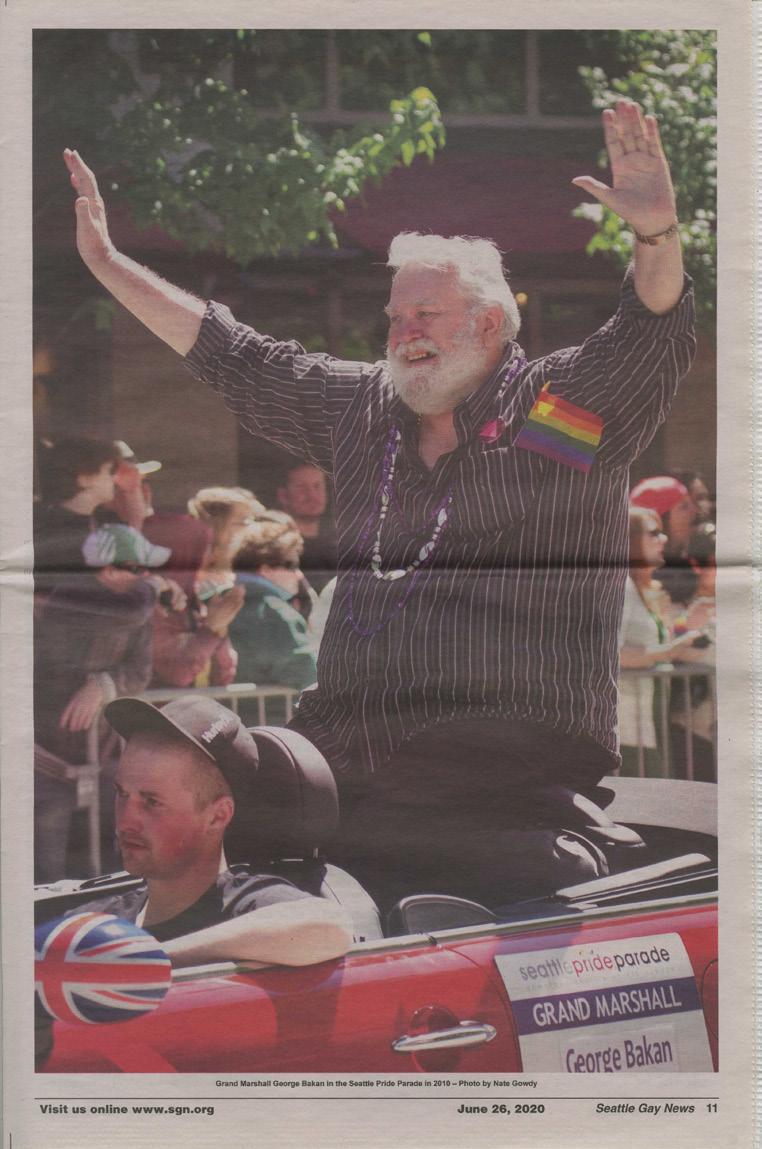
Source: Gustafson, Kristin L. Grassroots, Activist Newspapers from Civil Rights to the Twenty First Century : Balancing Loyalties and Managing Change. University of Washington, 2010.
While the panel in this exhibit about George Bakan that reports the financial difficulties at the Seattle Gay News is accurate – the Seattle Gay News struggled financially throughout its history – George wasn’t wealthy and George made huge personal sacrifices to keep the paper going – and staff who wanted to be a part of the Seattle Gay News’ mission and effort had to deal with that situation. We chose to deal with that or we left. Also, many contributors to the SGN volunteered their talents and skills over the years as well. Unfortunately, that panel doesn’t illuminate George's keen mind and heart, his creative and skillful use of the Seattle Gay News, his love for the LGBTQ+ community and beyond and his unflagging voice and leadership in the community to accomplish everything that he helped accomplish for Seattle's and Washington state's LGBTQ+ community from 1983 to 2020. So here is my tribute to George and a celebration of what he and others helped accomplish for Seattle ’s and Washington state’s LGBTQ+ community as reflected in this exhibit celebrating the 50th anniversary of the Seattle Gay News.
George made HUGE contributions to Seattle's LGBTQ+ community both locally and regionally as well as nationally by using the Seattle Gay News as a platform to build, support and advocate for the community, and move the quest for LGBTQ+ acceptance and equality in our society forward on so many levels. That is one of the reasons George was and is so beloved by so many in the community.
George welcomed, appreciated and published many voices and opinions from the community. George recognized good ideas and good writing and was able to find ways to utilize whatever talents an individual had to offer. George kept readers informed on local, regional, national and international issues related to the LGBTQ+ community with the help, creativity and contributions of a host of talented individuals whose names appear in the staff boxes and in the bylines and photo credits of the SGN over the years who were also committed to the cause. George always appreciated the support of the SGN’s advertisers.
Among his many accomplishments as an activist, George was a tireless advocate for people with AIDS. George started the grassroots Seattle AIDS Action Committee, which organized the "Unity Is Our Strength" community forum on AIDS that was held at the Broadway Performance Hall on August 7, 1983. The forum featured national AIDS spokesperson Bobbi Campbell and a panel of local AIDS activists that was widely attended. In October 1983, George and the Seattle AIDS Action Committee launched the first Seattle AIDS Memorial Vigil at Seattle Central Community College which continued annually thereafter on and around the Memorial Day Weekend through 1998 – which was later hosted and organized by several different LGBTQ+ community grassroots organizations over the course of that time period, including Mobilization Against AIDS Seattle, Lavender Magick, and The Sisters of Perpetual Indulgence. George felt honored to publish the many obituaries families and friends, lovers and partners, husbands and wives submitted to the Seattle Gay News for their loved ones who had died from AIDS or in other circumstances. As part of its recognition and commemoration of people who had died of AIDS, Seattle Gay News published a list of names of people who had died of AIDS in conjunction with the annual Seattle AIDS Memorial Vigil. George was also a strong supporter of the NAMES Project AIDS Memorial Quilt.
George’s contributions to Seattle’s and Washington state’s LGBTQ community were recognized by many community organizations – including Hands Off Washington, the Imperial Court of Seattle & the Olympic & Rainier Empire, and the Greater Seattle Business Association (GSBA). George tried to recognize and reflect the diversity of Seattle’s LGBTQ+ community in all its many facets in the pages of the Seattle Gay News.
George engaged with LGBTQ+ community leaders and public officials in Seattle and around the state working with them tirelessly to create and support positive change for the LGBTQ+ community. George spoke regularly on behalf of Seattle's LGBTQ+ community in response to questions from both print and television media. George served as a board member on the Northwest AIDS Foundation. George served on the Freedom Day Committee (Seattle's grassroots Pride Parade/March and Freedom Rally organizing committee) from 1983 to 1994, serving as FDC co -chair in 1984. George was involved in the Seattle -based United Front
Against Fascism's efforts and with the Northwest Coalition Against Malicious Harassment to thwart the Aryan Nations' activities in Washington state. George was an outspoken advocate for Bisexual and Transgender inclusion in the Lesbian & Gay Rights movement. Nations' activities in Washington state. George was an outspoken advocate for Bisexual and Transgender inclusion in the Lesbian & Gay Rights movement.
George supported LGBTQ+ and allied political candidates and elected officials in their efforts to serve in public office. Seattle Gay News supported SEAMEC – the Seattle LGBTQ+ Metropolitan Elections Committee that interviewed and rated political candidates on their knowledge and support of LGBTQ+ issues and people – by publishing their ratings free of charge in the Seattle Gay News twice a year that were appreciated by many candidates for public office and widely used by LGBTQ+ voters.
George was on the national steering committee for the National Marches on Washington, DC (for LGBTQ+ rights) in 1987 and 1993 and was co chair of the Pacific Northwest Region's National March on Washington, DC's organizing efforts for both events in which Seattle Gay News played an important and at times leading role. George was on the Washington Citizens for Fairness / Hands Off Washington coalition as a board member from 1993 through 1998 in its efforts to defeat anti LGBTQ+ initiatives in 1993 and in its effort to educate voters and achieve LGBTQ+ equality in Washington state through Initiative 677, which ultimately was unsuccessful at the ballot box in 1998.
George and the Seattle Gay News were actively engaged in the 30+ year lobbying effort in Olympia to pass anti discrimination legislation on the basis of sexual orientation and gender identity and expression in Washington state that was finally achieved with the passage of the Anderson Murray Anti Discrimination Law in 2006. George was a Grand Marshal at the 2009 Seattle Pride Parade.
George used the Seattle Gay News in concert with Washington state ’s LGBTQ+ and allied elected officials to educate and mobilize the LGBTQ+ and allied community ’s support for marriage equality in Washington state. That began with same sex domestic partnership legislation and Washington state voters ’ approval of Referendum 71 in 2009. Then careful, thoughtful and strategic work in the state legislature over the next 3 years led to the Washington State Legislature ’s passing Washington state’s Marriage Equality legislation and Gov. Christine Gregoire’s signing that legislation on February 14, 2012, which Washington state voters upheld at the ballot box with the approval of Referendum 74 on November 6, 2012. George worked with Seattle Mayor McGinn’s office to help shape the same sex wedding ceremonies held at City Hall on December 9, 2012 and arranged and coordinated free photography services to the wedding couples on that historic occasion.
George’s contributions to Greater Seattle’s and Washington state’s LGBTQ+ community were recognized with a night in his honor at Neighbours Nightclub to celebrate his leadership and contribution to the LGBTQ+ community in 2013.
George was co chair of the Capitol Hill Community Council in 2014 and helped broker the deal between the Seattle Police Department's East Precinct and Community Roots Housing (formerly Capitol Hill Housing) that turned SPD's surface level parking lot on 12th Ave just north of E Pine St into Community Roots Housing's 12th Ave Arts building featuring two black box theatre spaces, retail, office and community meeting spaces and a multi story low income and affordable housing project that moved SPD's parking lot underground.
George took great pride in helping to judge Seattle's La Femme Magnifique pageants and Seattle Pride's Pride Idol singing contests over the course of several years. George was a part of the community conversation about creating an LGBTQ+ community space and housing for LGBTQ+ seniors. George used the Seattle Gay News and his direct connection with it at every turn to advocate for and support the LGBTQ+ community in all its facets locally, regionally and nationally.
George was knowledgeable about antiques and collectibles. George also liked to buy sacks of potatoes when they were on sale at Safeway and donate them to the Union Gospel Mission.
Rick McKinnon

Seattle Gay News (SGN) has covered the many ups and downs, victories and set-backs, on the long journey to marriage equality and gay rights in Washington State, the United States, and beyond. As a newspaper by and for the gay community, SGN has long advocated for equal rights, doggedly reporting on the issues, keeping their readers informed, and holding opponents to account. While the road is long and the journey continues, we reflect on SGN’s coverage of these equality milestones in Washington State.
Seattle police officers David Estes and Dennis Falk formed Save Our Moral Ethics (SOME) to lobby for what became Initiative 13, an initiative to repeal Seattle’s antidiscrimination ordinances. The opposition, led by Citizens to Retain Fair Employment (CRFE), focused on privacy, claiming that the repeal would subject everyone to intrusive background checks by landlords and employers. On November 7, 1978 Initiative 13 was defeated – 37 percent voted in favor of repeal and 63 percent opposed – making Seattle the first city in the United States to vote in favor of gay rights. Tacoma, Spokane, and other Washington localities followed suit in later years.
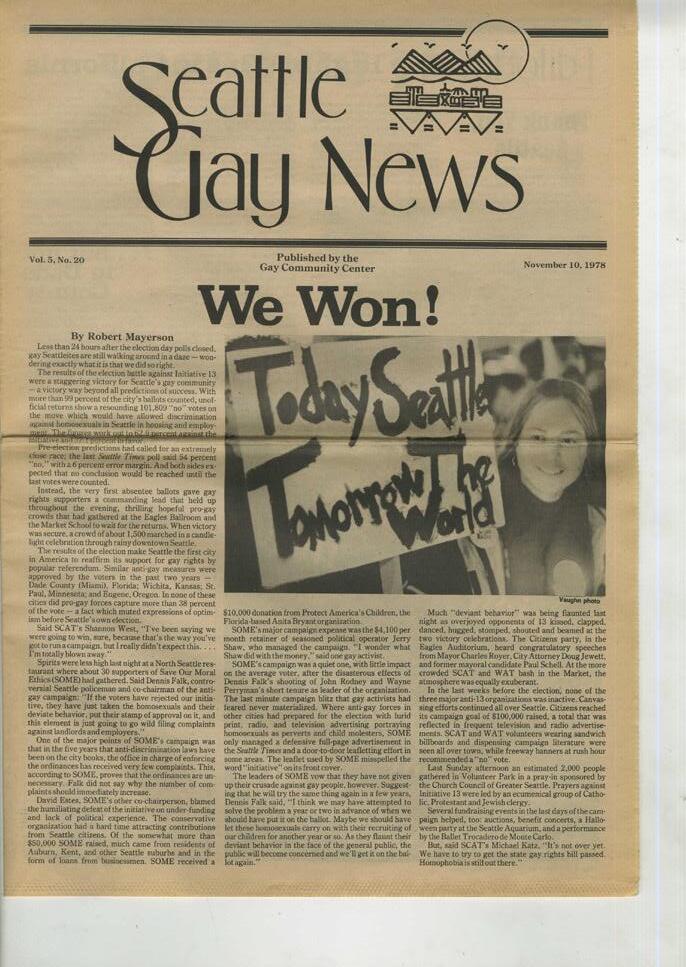

During her two terms as governor of the State of Washington, Christine Gregoire signed four laws that advanced gay rights.
On January 31, 2006 prohibitions on discrimination in employment, housing, lending, and insurance. In 2007, same gave lesbian, gay, and unmarried heterosexual couples with one partner over the age of 62 the right to visit a partner in the hospital, inheritance rights, and authority over autopsies and organ donations.

In 1996, Congress passed DOMA, an act that defined marriage as a legal union between a man and a woman, and provided that no state, territory, or Indian tribe should be required to recognize any other state’s same-sex marriage. President Clinton signed it into law on September 21, 1996 and in 1997, conservative legislators in Washington State introduced a bill prohibiting same-sex marriage. Governor Gary Locke vetoed the bill and vetoed a similar bill in 1998, only for it to be overridden by both houses in the Washington State legislature.
In November 2009, voters approved R-71, the “everything but marriage” bill, making Washington the first in the nation to ratify domestic partnerships for same-sex couples which granted all the state provided benefits that married couples have.



On February 13, 2012, Governor Gregoire signed a law legalizing gay marriage, making Washington the seventh state plus the District of Columbia to allow same-sex marriage. Opponents gathered enough signatures to block the law implementation and require a statewide voter referendum, R







R-74 received support from prominent Washington businesses such as Amazon, Starbucks, Nordstrom, and REI. Support also came from Washington newspapers, celebrities, athletes, and finally then President Barack Obama, the first sitting president to endorse marriage rights for all. Opposition fundraising was strongest from the National Organizations for Marriage and the Knights of Columbus, a Catholic fraternal service organization. Washington voters approved R-74 on November 6, 2012 by more than 53%. Voters in Maine and Maryland also passed same-sex marriage measures, becoming the first three states to approve marriage equality by popular vote.





On December 6, 2012, Washington’s marriage equality law took effect, making it the first state in the nation to issue marriage licenses to same-sex couples. The very first license went to Jane Abbott Lighty and Pete-e Petersen, more than 35 years after they became a couple. Many of the couples receiving the first licenses married on Sunday, December 9, the earliest date following the mandatory waiting period. Lighty and Petersen became the first same-sex couple in the nation to marry under a law enacted by fellow citizens.
After years of lawsuits and repeal efforts, the U.S. Supreme Court declared section 3 of DOMA unconstitutional under the Due Process Clause, thereby requiring the federal government to recognize same-sex marriages. In 2015, the Court ruled that same-sex marriage was a fundamental right also protected by the Equal Protection Clause, leaving Section 2 superseded and unenforceable. In 2022 DOMA was repealed by the passage of the Respect for Marriage Act signed into law by President Joe Biden.



Although Seattle’s then mayor Wes Uhlman declared the city’s first official Gay Pride Week in 1977, the first was actually held June 24 30, 1974 when 200 LGBTQ+ people, encouraged by the Stonewall uprising five years earlier, gathered publicly in collective resistance to expel shame and stand in defiance of those who wished to keep them hidden and disempowered.
The Seattle Gay News (SGN) has documented and advertised the events surrounding Pride ever since. From reporting on large events such as Seattle’s first official Gay Pride March in 1977 to smaller performances around the city and where to find them, SGN dedicates an issue to Seattle Pride each year.






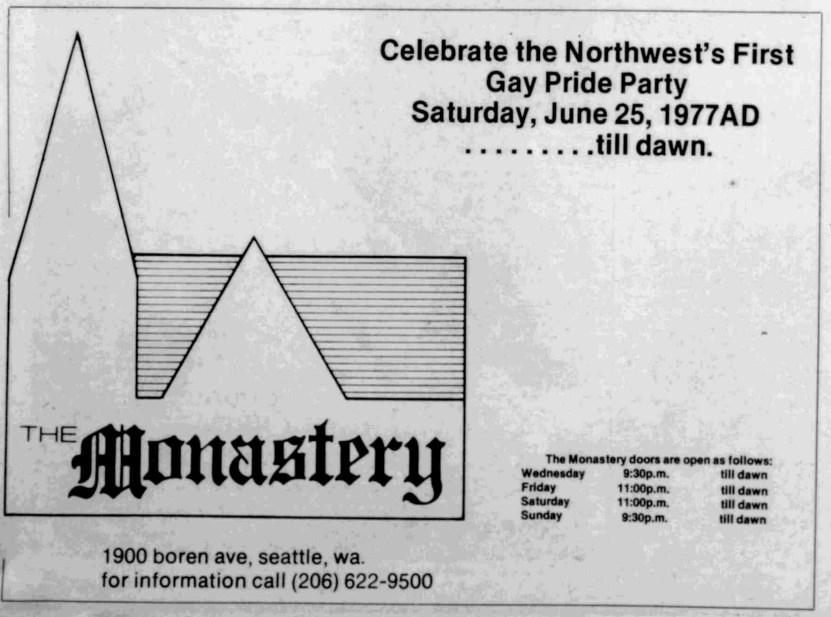
SGN Pride issues have special front page designs, usually with a rainbow theme to indicate the beginning of Seattle Pride Month. These issues often include special souvenir programs and/or pride features that act as guides for readers who want to participate in festivities. Pride issues include feature stories, events calendars, and advertisements for LGBTQ+ art shows and performances at Seattle’s annual Pridefest (one of the largest pride festivals in the country). SGN showcases pride events anyone can attend, encouraging participation from everyone in the Seattle area. Features and advertisements for queer owned businesses encourage patronage at local establishments.




Celebrating 50 Years of SGN


In June 1981, a spike in cases of Pneumocystis carinii pneumonia (PCP) and Kaposi’s sarcoma (KS) in healthy, young, gay men alerted health officials to possible outbreaks of rare, deadly diseases. A year later, the CDC identified the cause of these diseases, triggered by immune suppression, as Acquired Immune Deficiency Syndrome (AIDS).

The Seattle Gay News (SGN) was one of the first newspapers in Washington to cover the start of the AIDS epidemic. In SGN’s first issue of 1982, the headline “Cause of ‘gay cancer’ unclear” referred to the alarming rise in deaths of gay men from PCP and Kaposi’s sarcoma. SGN tried to explain the possible reasoning behind this trend, providing the gay community with valuable information while other mainstream newspapers ignored the emerging crisis.



On November 12, 1982, The
In contrast, the article above was one of the first about AIDS published in The Seattle Times. The headline “Deadly disease that mainly affects gay men surfaces in Seattle” is consistent with how other mainstream media initially portrayed AIDS as a “gay men’s disease.” Such coverage was prompted by the fear AIDS would spread outside of “at-risk” groups. While the mainstream press alienated gay readers, SGN and other publications by and for the gay community provided consistent, in-depth coverage of the epidemic through the 1990s and beyond.
(Left) The Gay Men’s Health Crisis organization educating gay men about how to have safe sex in order to prevent the spread of AIDS. It encourages men to live normal, healthy lives even if they are HIV positive, reducing stigma while providing a valuable health resource.
(Right) In “My trip to the AIDS clinic,” the writer details their experience visiting an AIDS clinic.
(Far right) Through perspectives of those living with AIDS or at risk for AIDS, SGN humanized those individuals to reduce stigma surrounding the disease.




From SGN’s origins as the newsletter of the Gay Community Center, the publication has been concerned with sharing relevant public health information with its readers whether through original reporting, or by giving page space to specific, eye catching, health focused public service advertisements (PSAs) .


This pamphlet was included with an SGN issue from late 1974. It educates readers on V.D.,” or venereal disease, and offers health resources. It was created by the Gay Community Center in cooperation with the Seattle King County Department of Public Health and the State of Washington Department of Social & Health Services.

Even though the most likely readers of these ads are gay men and members of the queer community, some ads still tended towards fear mongering as a means of targeting their audience. (The Northwest AIDS Foundation’s PSA falls on the opposite end of the spectrum.) Still, amidst changing health advice, medical advancements, and a global pandemic, SGN has remained focused on the health of its readership.
This PSA campaign, created by The Northwest AIDS Foundation and featured in the October 3, 1986 issue of SGN, empowers readers to curb the spread of AIDS by practicing safer sex. The focus of this campaign the sexual habits of gay and bisexual men proved controversial with mainstream media. Three Seattle area TV stations refused to air video PSAs from this same campaign.
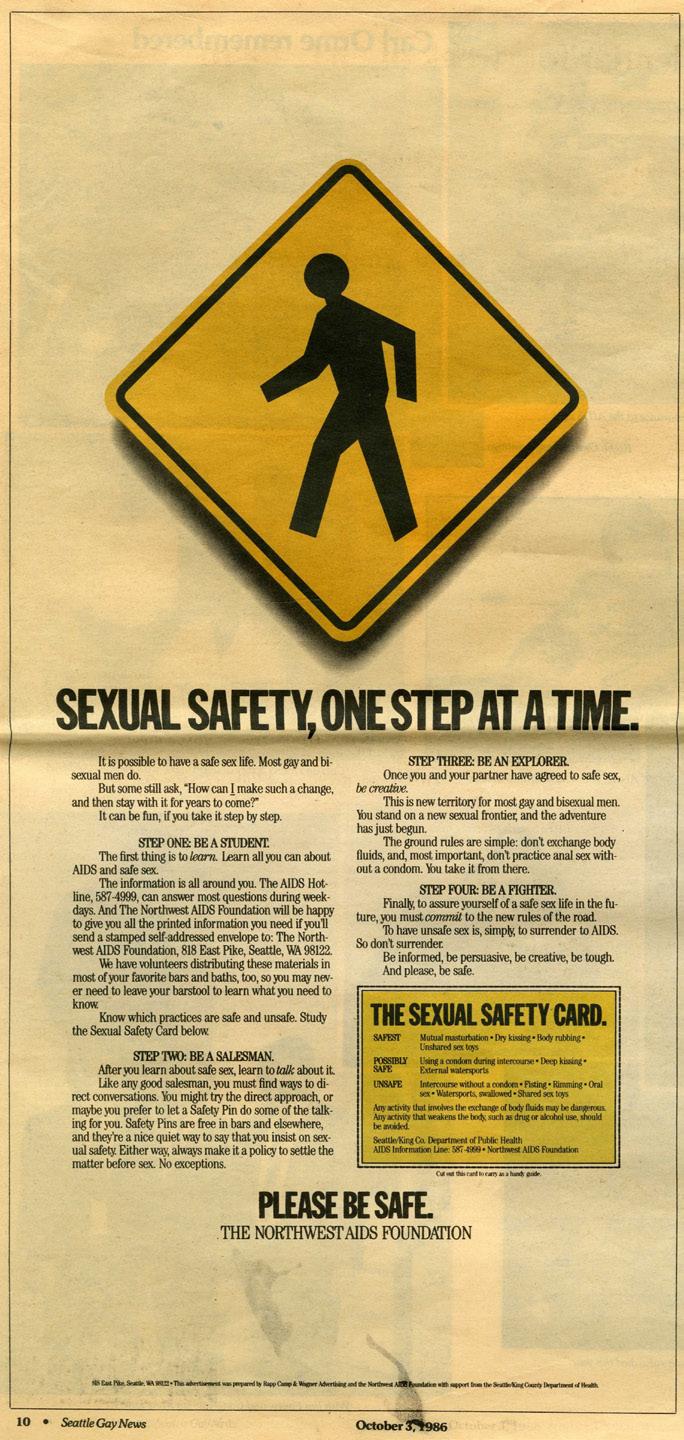
This full page ad ran on SGN’s back cover on April 10, 2020. The Washington State Department of Health’s straightforward PSA links to an official website, and is aimed at a general audience. A similarly straightforward PSA about vaccine development features on another SGN back cover in 2021.


A special section in the January 21, 2022 issue of SGN investigates rising STD rates in Seattle a potential result of testing centers being closed during the early days of the COVID 19 pandemic.

Steven Farmer was a Washington native who moved to Seattle proper in the early eighties after graduating from high school. Working as a flight attendant for Alaska Airlines, Farmer resided in the popular Capitol Hill neighborhood, the center of the Seattle LGBTQ+ community at the time.
Farmer was initially arrested on several felony charges including soliciting sex from minors. While in custody, Farmer asked two friends to go to his apartment to retrieve and destroy photos. Farmer eventually pleaded guilty to two misdemeanor counts of communication with a minor for immoral purposes. Farmer expected to be sentenced

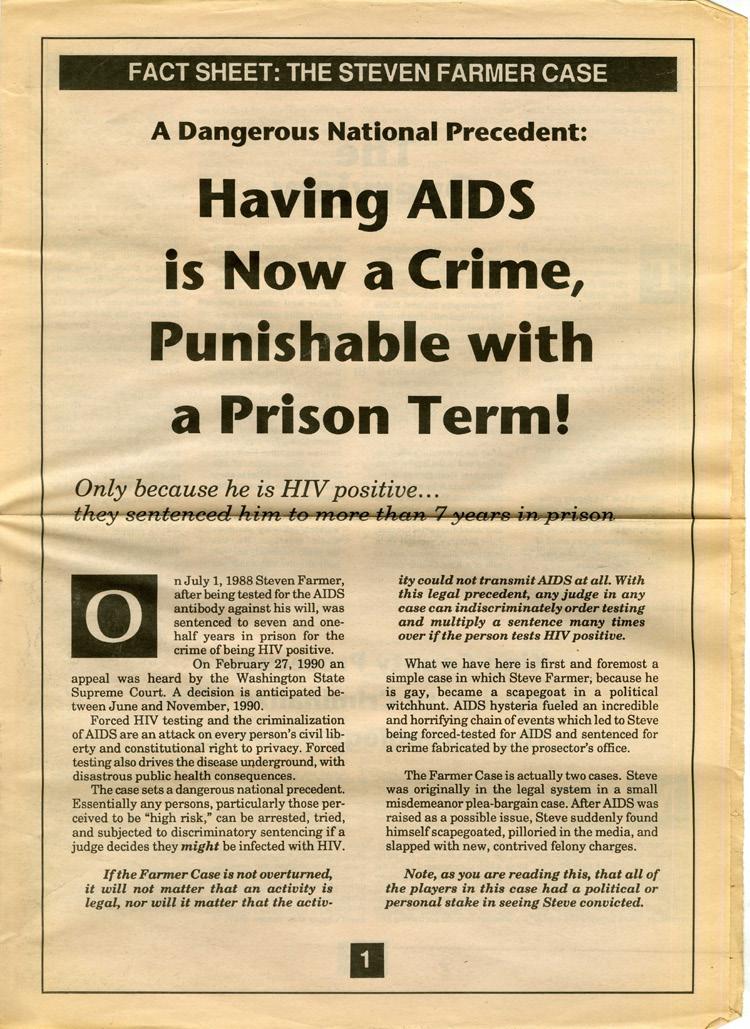

Instead, the friends that destroyed the photos told King 5 reporter Julie Blacklow that while in his home, they found textual evidence that Farmer had AIDS. Claims about his positive HIV test were picked up by the media and spread nationwide overnight. Farmer was portrayed as a villain who knowingly infected his partner with AIDS, although a witness statement from a friend is dated to 1983, two years before the first HIV test was approved for use.
Farmer’s sentencing was delayed and he was eventually charged with tampering with evidence. Two of Farmer’s alleged victims came forward to provide statements, resulting in more charges two counts of sexual exploitation of a minor and two counts of patronizing a juvenile prostitute, despite inconsistencies between statements.
Farmer’s case took an unforeseen turn, when Washington State legislators passed the AIDS Omnibus Act which mandated AIDS education in schools and ensured anonymous HIV testing except in rare cases such as people convicted of certain crimes and only for those committed after March 23, 1988, the day the law was enacted.
While Farmer’s trial occurred after that date, the crimes were allegedly committed a year earlier. Despite this, a judge ordered Farmer to take an HIV test, making him the first person in the state of Washington to be mandated to do so. The Farmer case enthralled the public and sparked a national debate concerning the violation of constitutional rights through forced HIV testing.
Ultimately, Farmer was sentenced to 7.5 years in prison far above the typical range for the severity of his crimes.
Farmer was given clemency in 1994 and passed away in hospice care from AIDS complications in 1995.
The Farmer case was complicated, with many twists and turns. For more information, see the HistoryLink.org article Farmer, Steven George (1956 1995)


The Steven Farmer case became a divisive issue in the local Seattle gay community and nationwide, sparking debate about the mandatory order for Farmer to take the recently approved AIDS test, public health, and privacy rights. Some resented Farmer and were openly critical of his crimes with minors and the shadow he cast on the gay community. Others acknowledged his crimes, but advocated against the violations of his human rights including the maltreatment he experienced at the hands of police and detainment officials, as well as the court mandated HIV test. The Seattle Gay News provided readers with up to date information of the case through its entirety. Coverage included reporting, letters to the editor, and exclusive interviews with Steven Farmer and some of his victims.







Through their letters to the editor of the Seattle Gay News, members of the gay community sympathized with Steven Farmer and protested the violations of his privacy and civil rights. Many letter writers vented their frustrations with mass media misrepresentations of Steven Farmer, especially using the case as a supposed exemplifier of the dangers of homosexuality.






While PrEP for HIV prevention is now part of the fabric of public health guidance, it is a relatively new medical development. SGN’s coverage of its development and approval paints a nuanced story of the local gay community’s reaction to the pharmaceutical advancement.
One of the earliest references to PrEP within the pages of SGN is in a column by a doctor in the March 4, 2011 issue (left). The author discusses a new study that shows the potential of an HIV prevention method where participants take a daily course of two medicines normally used to treat HIV. This is known as pre exposure prophylaxis, or PrEP. This initial study is only moderately successful, which sparks skepticism: detractors worry the drug combination will be falsely hailed as a silver bullet for HIV and discourage condom use.
This prompts a full page ad from the AIDS Healthcare Foundation in the next SGN issue (right), appealing to the drug’s manufacturer. This ad runs in gay periodicals nationwide. The next SGN issue features



coverage of this skepticism. The AIDS Healthcare Foundation goes on to unsuccessfully lobby against the FDA’s 2012 approval of Truvada for PrEP. SGN’s coverage remains wary of potential side effects, even as successive studies show conclusively promising results.
SGN’s coverage mirrors what becomes a national conversation about the benefits and drawbacks of PrEP for HIV. Critics of the drug argue that widespread adoption will decrease condom usage–a ubiquitous public health measure hard won during the height of the AIDS crisis. Proponents argue that an additional layer of protection against HIV will only improve quality of life for at risk populations.
By 2014, the CDC adopts PrEP as a recommendation for HIV prevention, and SGN publishes ads from local clinics that advertise to patients in need of a PrEP prescription.
Today, debates continue about the success of the widespread adoption of PrEP, but the gay community’s early skepticism has waned. Even the AIDS Healthcare Foundation, which had initially been highly outspoken against the adoption of PrEP, is now a provider of the drug.

7,


Before dating apps and online message boards, the SGN Classified section was a popular way for queer people in the Seattle area to connect. The paper included classified ads since its inception and, in response to a request issued in a letter to the editor, began accepting personal ads in April 1977. The letter (left) was written by a reader seeking a safe and private way to meet other queer people. The SGN editors agreed personal ads began running in the next issue.




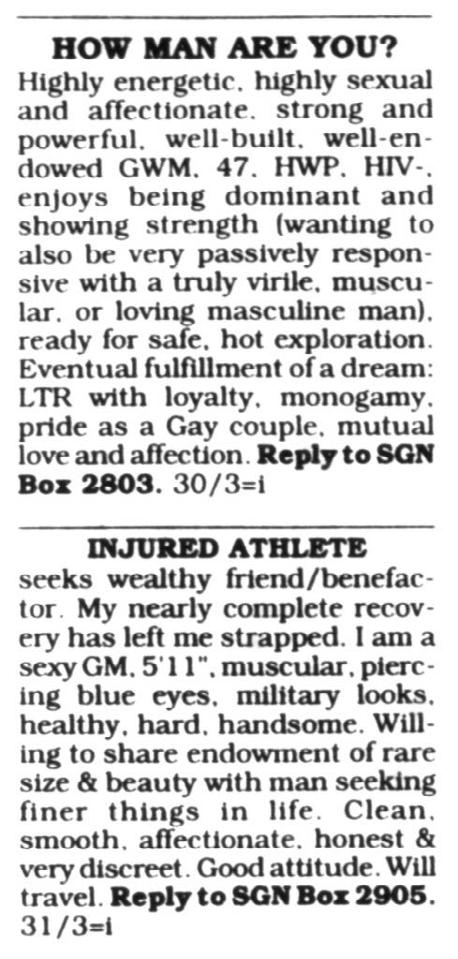




In the 1980s, SGN introduced a blind box system so those who placed a personal ad need not list their address or phone number. For an additional $2, readers could request a blind box to which ad responses could be delivered and then forwarded to ensure safety and privacy.
By the 1990s, SGN personal ads were accompanied by a plethora of ads for escort services, phone lines, and third party personal ad systems, including an automated system where users could place ads and receive responses over the phone for a fee.

As the internet became more accessible in the 2000s and dating apps and websites grew in popularity in the 2010s, SGN personal ads started to dwindle, going from a multi page spread to a half page as demand decreased. Currently, the classified section is no longer active.








Sergeant Perry Watkins voluntarily acknowledged he was gay when he was drafted into the United States Army in 1967 to fight in Vietnam. He was found “eligible for reentry for active duty” and reenlisted in 1970. While stationed in Germany in 1971 and 1972, Watkins performed at several events in drag, with the permission of his commanding officer. His performance was even reported in Army Times. Watkins reenlisted in 1975, and 1979, serving as a chaplain’s assistant, personnel specialist, and company clerk.
The Army denied Watkins security clearance several times throughout his 14 year career, despite glowing reviews from his commanders, but clearance was always reinstated upon repeal until 1981 when the Army moved to dismiss him. Watkins was back in his hometown of Tacoma, Washington, stationed at Fort Lewis. With the help of an ACLU WA lawyer, Watkins’ case worked through the courts. In 1989, a federal appeals court issued a groundbreaking ruling, finding that the Army could not change its mind after allowing Watkins to reenlist. Watkins retired with an honorable discharge.


The Seattle Gay News published over 150 articles about Perry Watkins. The newspaper reported on his military career and his fight to stay in the Army until he could retire with benefits after the required twenty years of service. Watkins told reporters: “after 14 years I’m not going to start from scratch again.” He told SGN: “if it benefits someone else in any way then it is worth doing.”
Unfortunately Watkins’ success did not lead to acceptance of gays in the military. The “Don’t ask, don’t tell” policy implemented during the Clinton administration flipped the script by barring openly gay, lesbian, or bisexual persons from military service. SGN covered DADT and cases of dishonorable discharges until the policy was repealed during the Obama administration.



A search for the keyword ’military’ in the Seattle Gay News (SGN), available through the Washington Digital Newspapers collection, retrieves nearly 4,900 articles, the majority of which were published during the 1990s when the Department of Defense issued Directive 1304.26, commonly known as “Don’t ask, don’t tell” which prohibited military personnel from discriminating against or harassing closeted homosexual or bisexual service members or applicants, while barring openly gay, lesbian, and bisexual applicants from military service. SGN published many articles about the status of gays in the military, some focused on politics and policy and others featuring service members discriminated against because of their sexual orientation.








Starting in the 1980s, the “On the Town” section of Seattle Gay News published a list and map of local bars, restaurants, bathhouses, and other businesses in and around Seattle that were safe spaces for queer people. Many of the businesses listed were advertisers in the paper.

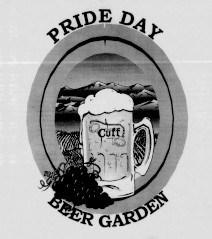


Seattle Gay News preserves the stories of generations of queer businesses. Some establishments, like the Cuff and Wildrose, are still open and thriving today, continuing to be safe spaces for the queer community. Others, like the Double Header, thought to be the oldest gay bar in the United States, have sadly closed their doors. While they no longer exist physically, the legacy of these havens is preserved in the SGN archives and in the memories of the communities who patronized them.



